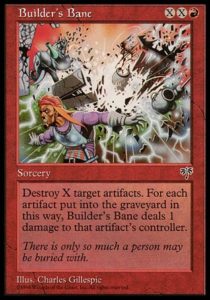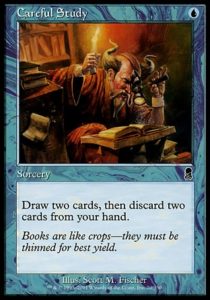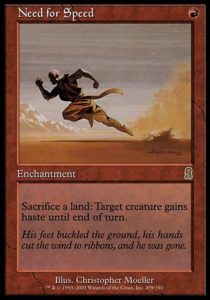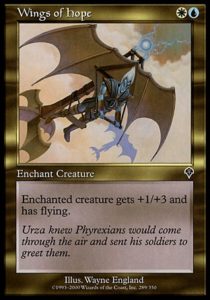Hello, friends! I’m back from the Regional PTQ in Newington, Connecticut. I split a hotel room with Chris Manning, because waking up at 4am in order to drive up is not a recipe for (personal) success. The morning of the tournament, we met up with Hugh Kramer, Sean Morse, Phil Napoli, and Jamie Parke—a murderers’ row of extremely talented Magic players, all far better sleepers than I (they all drove up that morning). That made five folks I definitely wanted to avoid playing (since they’re both quite skilled and folks I’d prefer to top 4 alongside, rather than at the expense of).
We six sat down alongside seventy-eight others in anticipation of seven rounds of Sealed, with a cut to Top Eight—with the same Sealed decks. This made it even more important to open strong pools than it is at a Grand Prix; in a Grand Prix, you can afford to lose twice to the insane decks and then get to draft a (hopefully) good deck and face fewer bomb-heavy decks. At the RPTQ, you’re essentially guaranteed to have to both play and beat the best pools in the room—since you’re extremely likely to face one in the Top Eight and a record of X-2 isn’t guaranteed to make Top Eight.
My pool was… okay. I had almost no creatures or removal in black or red (generally the best colors in Dragons Limited), so they were out. My blue was okay, but only had eight cards worth playing. It was also mostly CMC 3+ cards that cost UU, so none of them were splashable off my only fixing: a Tranquil Cove and a Swiftwater Cliffs. In the end, I eschewed blue and splashes, building this:
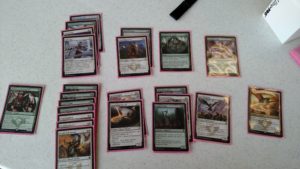
Good Curve, Nice Warden, and little else
I settled on green/white for three reasons:
- It had the most two drops (curving out is really important in Dragons of Tarkir).
- It had the most removal of any color pair (which was still paltry and entirely conditional).
- It allowed me to play my best card, Warden of the First Tree. Plus, Arashin Sovereign is a perfectly good beater that laugh at most control decks.
Sure, I was playing the nonbo of Conifer Strider + Assault Formation, though both cards did a ton of work (Conifer Strider is great against slow decks with removal and few creatures, whereas Assault Formation is an amazing mana sink). I was running an Abzan Runemark that should’ve been Great-Horn Krushok (I wanted to be aggressive, but the Runemark isn’t good with so few fliers and the Krushok works really well with Assault Formation). However, I think it was the best deck I could’ve built (absent the Runemark). It lacked mega-bombs like Dragonlords or Citadel Siege, but it was aggressive and had a few strong rares to lean on.
Still, it wasn’t a fantastic pool of cards, it wasn’t as aggressive as a good red-white or red-black deck could be, and I didn’t expect it to ever beat a resolved Whisperwood Elemental (though it could Return to Earth a Dragonlord or Citadel Siege). Not expecting to do very well in the RPTQ, I found all the drivers and told them to find me if they went 0-2; chances were likely I’d be joining them for the early trip home.
As you can tell from this article’s title, that didn’t happen. I squeaked into the Top Eight, and here’s how I did it.
Put in the Practice
When I arrived at the RPTQ, I knew that every participating player had won a PPTQ; everyone was good enough at Magic to win a tournament (of varying size). Accordingly, I expected everyone to be reasonably experienced at Limited. During deckbuilding and the first few rounds of play, I realized that I was in error. An apparent majority of players had qualified via Standard or Modern (not a problem, in and of itself) and many had hardly played Dragons Limited (a problem). Some people had never filled out a deck registration sheet. Some people seemingly never drafted.
It’s one thing to be out of practice (which is inadvisable for any tournament, but is at least understandable, given how long Dragons of Tarkir has been out and that Modern Masters prematurely made it ‘the old set’), but it’s another thing to have not played the format. I recognize that I’m very fortunate to have both Team Draft League and Twenty Sided Store to challenge me, but everyone has access to the competition of Magic Online 8-4s. While several players were Limited ringers, far more were clearly nervous to be playing cards intimately familiar to drafters but utterly alien to Standard grinders. I won several games with a worse deck than my opponents’ because I had experience and comfort with the format that they lacked.
If you’re going to a tournament, any tournament, practice! Sure, the RPTQ is exciting, free, and has great prizes just for entering, but why not put in the work and try to win it?
Build the Right Deck
There’s a recipe for success in Sealed: open well and build well. Opening well is out of your control, but finding the right build never is. The basics of Limited are relatively constant, shifting only slightly from set to set:
- Have a good curve. This is more important in Dragons Sealed than it was in Khans Sealed. The format can be very aggressive and there are few ways to regain lost tempo. You never want to fall too far behind.
- Don’t stretch your manabase. The best decks are generally two color, perhaps with a very light splash that is supported by fixing.
- Play your bombs. Fate Reforged and Dragons of Tarkir have some insane bombs, like Citadel Siege, Whisperwood Elemental, the Dragonlords (except for Kolaghan, who’s merely great), and the Regents. They’re worth splashing for, if you can afford them.
- Know your game plan. Are you playing control until you find your game-enders? Are you aggressive? Are you going wide or relying on protecting a single threat? Do you have enough disruption to stop your opponent’s aggression or speed to stop their control?
Everyone wants to open an insane pool with the best bombs, and the RPTQ awards it more than a Grand Prix (because you never change your deck and probably can’t afford to lose twice). However, you’re not statistically likely to open one of the best pools in the room. In that case, you should build a deck that can beat the best decks. The better you do in a tournament, the more guaranteed you are to face the best decks, so why not assume that you’ll do well and pre-board for your toughest and most important matchups?
- Maindeck cards that beat the bombs. Plummet kills all Dragons. Naturalize destroys Citadel Siege, Mastery of the Unseen, and Berserkers’ Onslaught. Counterspells can stop both.
- Be aggressive. If the best decks are going to have multiple insane, perhaps unbeatable mythics, then why give those decks a chance to find and resolve them? Kill them before they can ever cast Ugin, the Spirit Dragon or Dragonlord Atarka!
- Be consistent. The player with Dragonlord Ojutai, Dragonlord Dromoka, and Dragonlord Silumgar has good reason to stretch their manabase. Let them suffer from color screw and die with bombs in hand while you dump yours.
By round 4, at 3-0, I found myself at table #1. My deck was already tuned for my worst matchups (namely, the best decks). It certainly wasn’t great, but it had game against the best decks, those most likely to sacrifice speed and consistency for raw, game-dominating power. For three rounds, I played against folks who would make Top Eight, going 1-2. By round 7, I was all but guaranteed to not crack the Top Eight, but I’d at least had a fighting chance along the way.
That’s all for this week. Next week, I’ll return with Round 7, the Top Eight (Spoilers! I made it!), and my thoughts on the RPTQ system. As ever, thanks for reading. See you next time!
—Zachary Barash
Zachary Barash has been playing Magic on and off since 1994. He loves Limited and drafts every available format (including several that aren’t entirely meant to be drafted). He’s a proud Cube owner and improviser with an obsession with Indian food that borders on being unhealthy.

